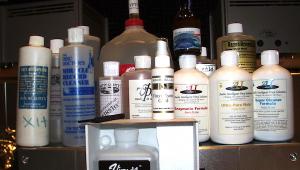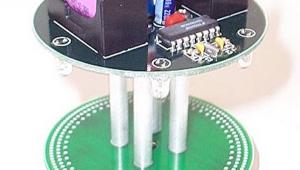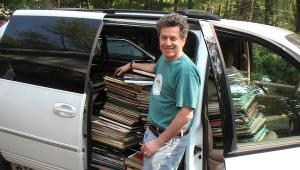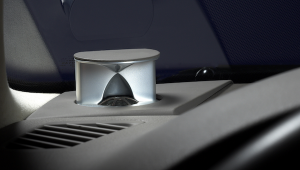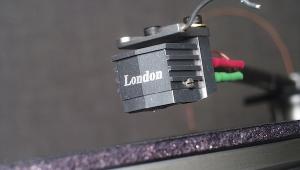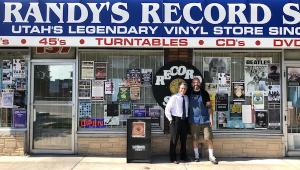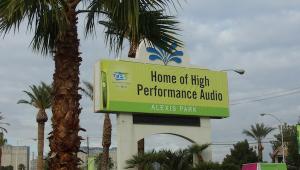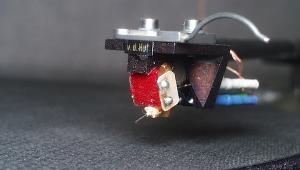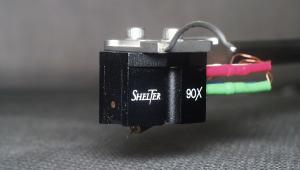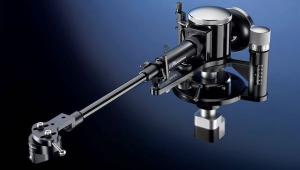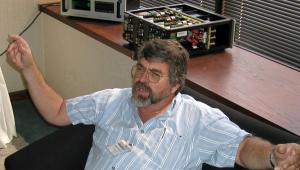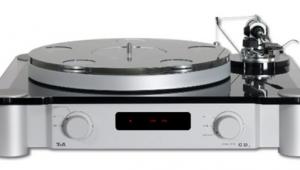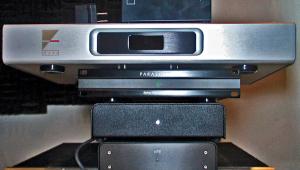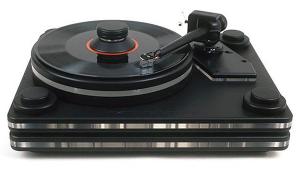Analog Corner #39

(Originally published in Stereophile, October 12th, 1998)
Are you old enough to remember when New York State, much of the rest of the Northeast, and parts of Canada were blacked out by a power failure on November 19th, 1965 at 5:18pm? I was in my Phi Sigma Delta frat-house library at Cornell, HO model-car racing—for money. At the flick of the wrong switch, all bets were off for the night. I'll never forget that.
Where were you when you heard your first compact disc? I'll never forget where I was: at an early-'80s AES Convention in Los Angeles. It was Roxy Music's Avalon played on a refrigerator-sized machine, and the sound was as awful as the technology was brilliant.
I may not have been listening as an industry insider on the playing field of the audio biz, but I wasn't exactly a spectator in the stands, either. I was kind of on the sidelines. You have to at least be on the sidelines to attend an AES demo of the new electronic future.
To hear genuinely foul sound declared not just great but essentially "perfect" was nightmarish, but what to do from the sidelines? Scream? I did. I called friends and warned them "They're coming! They're coming!" like Kevin McCarthy in the original Invasion of the Body Snatchers. I wrote hysterical, ineffectual articles about the coming "digital madness" in obscure magazines. I attended the Consumer Electronics Show wearing a cardboard facsimile of a CD (they didn't even have real ones yet) on my chest, on which I'd painted the red ring-and slash "no" symbol.
And I paraded before The Compact Disc Group's table wearing it, behaving like a PETA member camped out at a slaughterhouse. It didn't hurt that a certain PR fox named Leslie Rosen was womaning the booth, but I would have done it had Eleanor Roosevelt been sitting there. Or Stereo Review's Ken Pohlmann, for that matter. Especially Ken Pohlmann. Did I tell you that, in a broadcast debate I had with him on the CBS radio network, he declared that he'd "skipped over" the LP era? Now there's a genuine music lover.
Well, now I can ask another question: Where were you when you heard your first 24-bit/96kHz DAD disc? Or Sony's SACD? Those who attended HI-FI '98 will be able to answer "June 1998 in Los Angeles," but the rest of you soon will be able to. And I've finally heard 24-bit/96kHz Classic and Chesky DADs in my own system (thanks to Ayre's Charlie Hansen, who lent me a prototype player). Like the blackout and that first CD, it was an experience I'll never forget. As I listened, I thought to myself, "This time you're on the playing field. So what do you think? And once you've formed an opinion, what are you going to do about it?"
What I'm going to do is scream again. I think all but the hopelessly analog-addled among you are going to like what you hear. No, I think you'll be thrilled. These discs image with solid, palpable, layered three-dimensional focus. They're harmonically rich and dynamically big. Bass is a groin-grabber, not some mealy-stringed blob. DADs sound much better than CDs, and I'll take double-blind ABX tests all day, if need be, to prove it to the "Nyquist is God" crowd. I'll be declared a "lucky coin" again, of course, but I've been called worse.
Of course we'll still love, cherish, and prefer listening to our records—that's a different thing—but we'll finally be able to put on a digital disc and get a vinyl-like kick, musically and sonically. New music finally will sound as good as old music—perhaps even better.
Maybe.
Maybe? Yes, because the same people who've made you and me suffer musically for the past 15 years are trying to block our relief! As far as they're concerned, 24-bit/96kHz resolution is a waste of resources, overkill. If we've already got perfection, why bother with something that can't, by definition, make an improvement? Instead, they're proposing to add three more channels of their version of "perfection" to the two they've already stuck us with. Isn't that special?
Don't discount them—cumulatively, they've got the ears of many more listeners than we do. And numbers count big time to the record companies when they're considering supporting a new format.
There are even some who'd be happy with 5.1 channels of Dolby Digital, which throws 90% of the music out—but hey, the average guy can't hear the difference in tests, so it's perfect. After all, what are we, a bunch of elitists?
Well, I'm in the game this time, and the last thing I think I'll do is ride it out in the backfield. The editor of another audio magazine wrote recently that he's not sure if he can hear the difference between 16-bit/44.1kHz audio and 24-bit/96kHz. Mastering engineer Bernie Grundman thinks any guy pulled off the street could hear it, but this editor writes about it as if it was a Jackie Mason routine: "I may have hoid a difference, could be, I might have...but maybe not. I think on Tuesday I hoid something, but Wednesday? Nah! I don't think so. Thoisday? Maybe, it could be I hoid a little thing, but probably not—or maybe I hoid a big thing, I don't remember. I think I better sit there with an ABX box to make sure I'm confused. Mista? Hey, mista? Did you hear something?"
And former NHT head honcho Ken Kantor, a guy I respect greatly for the most part, is even more adamant in that same magazine: If you know Nyquist, you know that 16-bit/44kHz is transparent to the source, is his take. I can't believe he's even taken the time to sit down to listen and compare these DAD discs to the standard CDs.
So what do I make of my audition of John Lee Hooker's Mr. Lucky, comparing CD to Classic Records DAD to digitally sourced import vinyl, in which contest the DAD absolutely humiliated the CD and LP? On well-recorded tracks like "This is Hip," recorded at OceanWay with Ry Cooder, and "I Cover the Waterfront," with Van Morrison and Booker T., the difference was anything but subtle. And it wasn't the mastering—on the other Classic titles where Bernie Grundman mastered both formats, there were the same differences. In place of the typically diffuse, unfocused CD soundstage, the DVD offered up fixed, rock-solid, focused images—in layers—with deep, tight, dynamic bass. Like good vinyl, but in some ways even better. And in some minor ways, perhaps not as good.
Same thing when I compared Chris Whitley's superb Dirt Floor, available as a standard CD from Messenger Records, and as both DAD and 45rpm vinyl from Classic. This comparison was particularly telling because the pristine recording is so revealing. It's a single-point stereo tube-mike job recorded live to two-track analog and produced by Craig Street—just Whitley in a tool shed, playing slide guitar and banjo and singing. The "Thank yous" in the credits include Audio Research's Terry Dorn, EAR's Tim de Paravicini, and ProAc importer Richard Gerberg. This is an "audiophile-quality" commercial release all the way.
The CD, mastered by Greg Calbi, sounds warm and inviting, but there's little "there" there. I had trouble seeing the event in focus. Not so with the DAD. The difference was startling and unmistakable. When I played the 45rpm record, aside from a bit more noise and perhaps a slightly richer sound, the differences were minimal. I could sit and actually listen to, and thoroughly enjoy, DADs. Yes, "I" means you.
The sides are lining up in this battle. Even if you're in the stands, you'd better start screaming or we'll be stuck with CD forever—or, worse, 5.1 channels of Dolby Digital. That's okay for movies, but not for music.
Back to reality
We'll see how the DAD/SACD conflict plays out, how many titles become available, how much the players end up costing, and the rest over the course of the next few years. Meanwhile, I'm sitting here enjoying the new Van Morrison 20-bit CD remasters played on a multi-thousand-dollar CD player, but when I compare them to original vinyl on the $299 Music Hall MMF turntable, guess which sounds more enjoyable? Yes, the budget 'table has more noise lurking under the music, but the vinyl still has better focus and depth, and more rich "there" there. That won't change until the format does.
The flat-belt/crowned-pulley-drive MMF (no relation), made in the same Czech Republic factory as Sumiko's Pro-Ject series, features a 41/2-lb alloy platter and stainless-steel and bronze bearing assembly. Some designers, including Rockport's Andy Payor, think flat-belt/crowned-pulley drive is the best way to go for lowest wow and flutter.
The 9" (effective length) arm is reminiscent of the better late-'60s Dual arms, which featured dual-bearing gimbaled pivots. The arm's VTA and azimuth are both fully adjustable; even the counterweight is "decoupled" on a squooshy elastomer—as is the motor assembly.
A Goldring Elan cartridge comes installed, and it will get you through the night. It tracks well at 1.7gm and provides a warm, midrange-rich overall sound with images that are noticeably larger than life, but that give you a startlingly different (and enjoyable) take on your favorite records—especially if you're used to hearing them reproduced using far more expensive, higher-resolution cartridges.
I particularly enjoyed listening to a mint original mono pressing of The Byrds' first album I picked up for three bucks at a record convention. Apparently there are still dealers who don't know the original mono versions of many rock records have become more valuable than the more common stereo versions. The bass line "pops" beautifully on the MMF/Elan combo, with a rich, surprisingly tight focus.
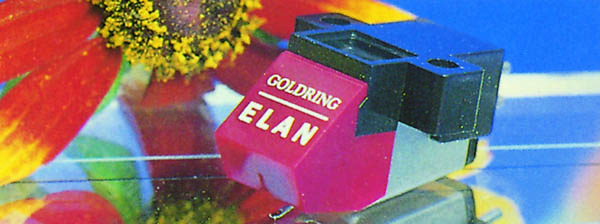
Substituting a Sumiko Blue Point cartridge (you're not going to really want to live with the Elan long-term) reinforced that the MMF is a damn fine performer—a chronic overachiever that offers a satisfying and fundamentally correct overall sonic balance. The key to the MMF's success is that it doesn't try to do too much. Every parameter is scaled back proportionally compared to far more expensive 'tables, except for noise, which is upped by the same amount.
So while the MMF doesn't give you ultradynamic deep bass, what it does give you is taut and rhythmically lithe—and because it's well connected to the rest of the presentation, you really don't notice what's missing because nothing sticks out. You get a little less of everything—especially dynamics—for a lot less money. My sample ran about 0.5% too fast, which is hardly noticeable.
Physically, 'the table pulls the same balancing act. The bearing appears to be precision-made, but it's nail-thin in diameter and connected to a lightweight plastic subplatter. The motor-and-pulley assembly is bare-bones, but surprisingly well designed and -manufactured, especially for this kind of money. The fully adjustable arm is a pleasure to set up and use—I didn't hesitate to play some of my better records with it.
Add the paper-and-cork Ringmat record-support mat—also imported by Music Hall, and costing about a third of the price of the entire 'table (!)—and the sound improves even more, especially the bass. The MMF is a great way to step into analog on a budget. You won't be disappointed. And setup is simple, as the cartridge comes pre-mounted.
If you have about a third more shekels to drop, you could consider NAD's variation on the Rega 2, the 533 ($449), which uses an MDF platter in place of Rega's glass. As with the MMF, the NAD comes with a felt mat. For those unfamiliar with the Rega design, it uses a plastic motor pulley and an $wO-ring to drive a plastic subplatter. The 533 comes equipped with a Goldring Elektra, a higher-priced variation of the Elan, which also tracks reasonably well at 1.7gm.
The Rega/NAD 533's spindle bearing has a considerably larger diameter than the MMF's, and, I suspect, a higher tolerance as well. The Rega RB200 arm is an ultrarigid one-piece cast-aluminum design that offers superb value/performance for the money. The one drawback—though some, like Rega's Roy Gandy, don't consider it one—is the lack of VTA and azimuth adjustments. Gandy favors rigidity over flexibility, and in any case doesn't believe audible differences from changing VTA are actually due to VTA. He thinks they're more due to minute changes in overhang caused by the height change, or "slop," in the adjustment mechanism. He also thinks it's the cartridge manufacturer's job to get the azimuth correct. Love those idealists.
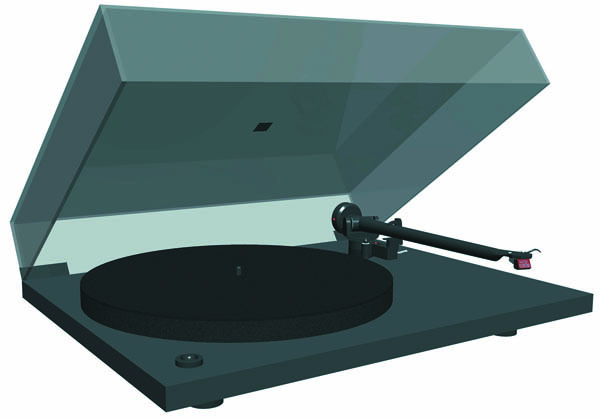
Anyway, the NAD 533/Goldring Elektra is another great bargain. Like the MMF, it, too, is a very strong performer and an incredible value for the money. I enjoyed listening to it for hours at a time—especially with the Ringmat in place of the felt mat. It gives you that certain relaxed analog "something" that no CD player at any price can.
Is it worth the one-third-higher price? The Elektra, while still not what you'll want to end up with, does offer better focus and detail than the Elan, and slightly better extension at both ends of the spectrum. Thus the 533 offers more refined sound straight out of the box than the MMF does, and will instantly provide greater listening satisfaction as a "plug'n'play" product.
But with the $195 Blue Point optimally installed, the MMF beats the stock 533. Put the Blue Point on the 533 and you get a pretty tight match, though the 533 offers lower background noise, slightly better dynamics, and is, overall, a more ruggedly built product. Then again, if your aim is to change the supplied cartridge in the first place, you should consider the Rega 2 at $495 with glass platter and no cartridge.
On the other hand, the MMF arm's setup flexibility gives you the opportunity to really optimize performance with the cartridge of your choice. The MMF is a budget tweaker's delight, the 533 an out-of-the-box pleasure. At $299 and $449, both are attractive "plug'n'play" options for anyone wishing to return to analog on a budget. (For a more detailed sonic evaluation of the Rega Planar 2, which is very similar to the 533, see Stereophile, Vol.19 No.12.) Phono drive Have a preamp with only a line section? NAD makes the ridiculously inexpensive ($129) PP-1 MM phono preamp, made in China and featuring a separate outboard power supply (a wall-plug power transformer, actually) and a neat little gray box with gold-plated RCA input jacks and hard-wired output cables.
As I was about to audition the PP-1, the Thor Phono-Burn showed up. It's a $350 lifesaver for any analog audio reviewer, and anyone else wishing instant sonic gratification from a phono section. You plug a CD player into it, and it into your phono section. Thor supplies a special CD with signals for both MM and MC cartridges. The Phono-Burn drops the CD player's line level and applies the inverse of the RIAA curve to the signal before sending it to the phono section's input. Set your CD player on "repeat" for either the MM or MC CD track and let it cycle for a day or so. If you have your phono section connected to your system, the signal can also "burn in" your entire system.
Of course, without an ABX box, burned-in and cold-out-of-the-box units to test, and 25 or so rounds of mind-numbing comparisons, my observations are without scientific merit and therefore devoid of value. But does it work?
Before-and-after auditions tell me yes.
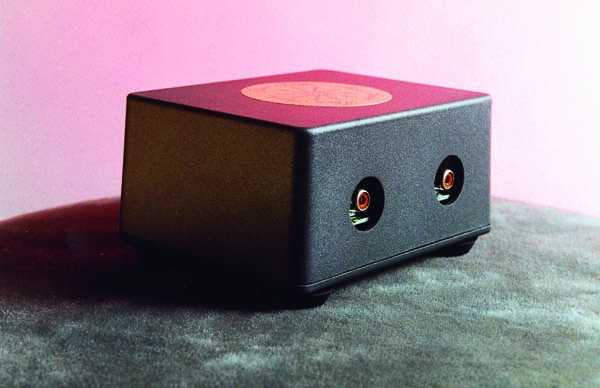
Anyway, the Thor is a great accessory for the well-heeled audiophile, and certainly a worthwhile investment for any audiophile club or collective to keep on hand and lend out when needed.
Back to the PP-1: At $129, you could go wrong only if it stank. It doesn't. I don't have the $199 Creek OBH-8 here to compare it to, or the $249.95 Musical Fidelity X-LP, so I can't give you a 1–2–3. I can tell you that the PP-1 (MM only) errs on the side of warm, soft, and listenable, which goes along with the capabilities of the turntables with which it's likely to be used.
The PP-1 is a pleasant-sounding, low-noise piece that, while lacking dynamic and transient excitement, sounds surprisingly rich, round, and satisfying—as long as you don't expect too much for so little money. The PP-1 homogenizes detail and pushes images toward the center of the stage, but for $129 you'd have no business complaining about some etch and grain, neither of which the PP-1 makes you suffer with. If you're slowly creeping your way back to analog or just want something to use to play back a small collection of records, the PP-1 is the lowest-cost path of least resistance.
That said, you won't believe your ears when you hear the Lehmann Black Cube phono section, imported from Germany by Hy End Audio Imports. This $695 MM/MC need not apologize for itself in any way at any price—that's how good it is. The Black Cube consists of an outboard power supply with IEC AC jack so you can play with power cords, and a small (114mm by 44mm by 108mm) metal-chassis main unit connected via a shielded, hard-wired cable.
The carefully filtered power supply (explained in great detail in the instructions) includes high-speed diodes and precision voltage regulation. RIAA equalization is accomplished passively between two amplification stages, with no series capacitors in the signal path except for the subsonic filter. High-grade Analog Devices op-amps are used (MF owns AD stock), and caps in the RIAA filter network are 5% tolerance WIMA MKS—all taken from the same "reel" to keep tolerances tight, according to the literature.
Internal DIP switches allow you to adjust for MM/47k ohms and four MM loads plus one custom, for which you insert a resistor of a value of your choice. Given its cost, the Black Cube's specs are astonishing. For instance: 61dB of gain at 1kHz in MC mode with a S/N ratio of 69dB.

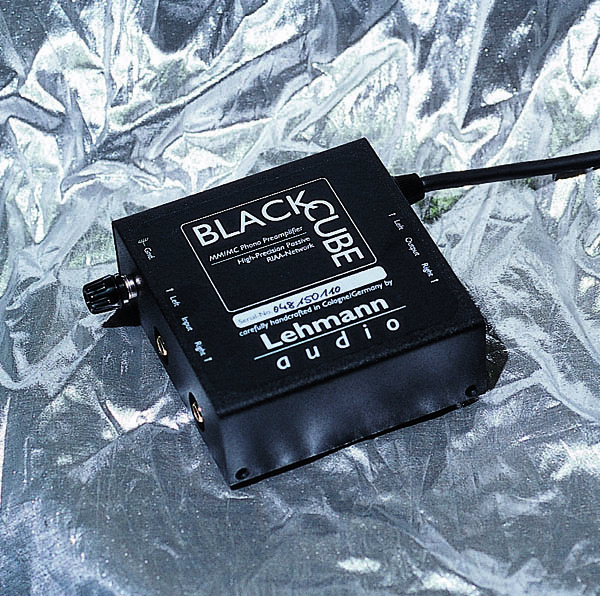
The numbers tell you "quiet," and so does the sound. The Black Cube had no problem handling the Parnassus D.C.t's low (250µV) output, and, with its low output impedance (!x100 ohms), drove the Ayre K-1's line section to very loud levels. What's more, raising the cueing lever yielded dead silence.
As for the Black Cube's sound, the first thing I noticed was how fast and detailed it is; how it got leading edges and transients essentially correct. The second thing I noticed was how well it handled large and small dynamic swings—which can spell the difference between hearing canned music and the illusion of live.
I've been playing Classic's excellent reissue of Dexter Gordon's A Swingin' Affair (Blue Note/Classic ST-84133) a great deal lately through the Ayre's built-in phono stage and the excellent $2000 Pass Aleph Ono, and you know what? The $695 Lehmann need make no apologies. It plays in the same league as the big boys.
Sonny Clark's front-and-center piano may not be as fully fleshed-out as with the expensive phono circuits, but its focus is superb, and harmonically it's more than credible. Ditto Billy Higgins' drum kit off to the right. Yes, Dexter's not quite as grounded as he can sound, or as richly presented as I've heard, but there's plenty of air and space around his tenor, and the whole thing swings like hell, even though the bass suffers a bit compared to the expensive spreads.
I don't know if it's offered with a money-back guarantee, but I'd say if you're unhappy—or, especially, bored—with your phono section, built-in or separate, and you're on a budget of $1200 or under, get your hands on the Lehmann Audio Black Cube. I don't know of anything at or near the price, or maybe even twice the price, that sounds this good.
